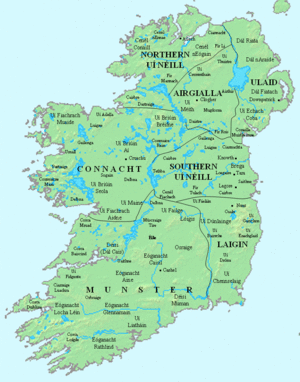Soghain facts for kids
The Soghain were an ancient group of people who lived in Ireland a very long time ago. A smart writer from the 1600s, named Dubhaltach Mac Fhirbhisigh, said they were part of a bigger group called the Cruithin. He wrote that the Cruithin included the Dál Araidhi, the seven Lóigisi groups from Leinster, the seven Soghain groups across Ireland, and all the Conaille people.
Contents
Where Did the Soghain Live?
The Soghain people lived in different parts of Ireland. We know about at least four of their main locations:
- One group lived in an area called Fernmag, which is now known as Farney in County Monaghan.
- Another Soghain group lived in Delvin in County Westmeath. They shared a special area called Trícha cét na Delbna Móire agus na Sogan with another group called the Delbhna.
- The Corcu Shogain were a Soghain group linked to the Benntraige people, who were under the Eoghanacht. An ancient stone carving, called an Ogham inscription, was found near Aglish in East Muskerry, about twelve miles west of Cork. It says MUCOI SOGINI, which likely means "of the Corcu Sogain."
- The Soghain of Connacht lived in a kingdom called Soghan, located in the middle-east part of County Galway.
The Kingdom of Soghan in Connacht
The Soghain people in Connacht lived in their own kingdom called Soghan. This area was in the central eastern part of County Galway. It was bordered by the river Suck to the east and the river Clare to the west. To the north were the Grange and Shiven rivers, and to the south were the Raford and Ballinure rivers.
An old poem found in The Book of Uí Maine, called Cruas Connacht clanna Sogain, describes the borders of this kingdom. These descriptions match the river locations mentioned above.
Before the Gaelic people arrived, another group called the Senchineoil lived in this area. We don't have much information about them.
A poet named Seán Mór Ó Dubhagáin wrote about the Soghain of Connacht in his poem Triallam timcheall na Fodla. He said: "The six Sogain let us not shun / Their kings are without oblivion / Good the host of plundering excursions / To whom the spear-armed Sogain is hereditary." This means they were a strong and memorable group.
The Book of Lecan, another old text, lists six main branches or families of the Soghain. These were the Cenél Rechta, Cenél Trena, Cenél Luchta, Cenél Fergna, Cenél Domaingen, and Cenél Déigill.
One famous person connected to the Soghain was Saint Kerrill of Clonkeenkerrill. His family tree shows he was a descendant of Soghain Salbhuidhe. His grandfather, Treana mac Fionnchada, gave his name to the Cinel Trena group. This group lived near Knockma, in an area called Tír Mhic Trena, which means "the land of the sons of Trena." This was the western edge of the Connacht Soghain kingdom.
Many early Christian teachers and saints worked among the Soghain people. Some of them include Conainne, St Connell, and Kerrill. Other important religious figures from the Soghain area were Naomhéid, Cuana of Kilcoonagh, Dubhán, Felig, Íbar, Íomar of the Sogain, Laisren of Clonkeenkerrill, Maol Chosna, Modiúit, Menott, and Molua of Kilmoluagh.
Many local church areas, called parishes, were part of the Soghan kingdom. These included:
- Abbeyknockmoy
- Abbert / Monivea
- Ahascragh
- Athenry
- Ballymacward
- Clonkeenkerrill
- Fohenagh
- Kilcloony
- Kilconnell
- Kilgerrill
- Killascobe
- Killosolan
- Kilmoylan (part)
- Lackagh (part)
- Moylough
Over time, during the first thousand years AD, the Soghan kingdom became part of the larger Uí Maine territory.
Who Are the Soghain Descendants Today?
Even today, many people in County Galway are believed to be descendants of the Soghain. Their family names often include Ó Mainnín, Mannion, Manning, Ward / Mac an Bhaird, Gill / Gillane, Scarry, Dugan / Duggan, Megan / McGann, Martin, and Cassain.
See also
- Clann Fhergail
- Uí Fiachrach Aidhne
- Clann Taidg
- Conmhaícne Mara
- Delbhna Tir Dha Locha
- Maolán
- Muintir Murchada
- Trícha Máenmaige
- Uí Díarmata
- Cóiced Ol nEchmacht
- Síol Anmchadha
- Maigh Seola
- Cenél Áeda na hEchtge


